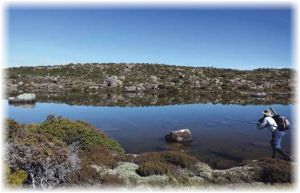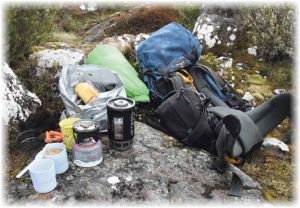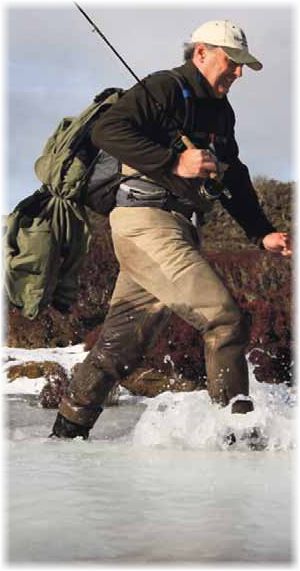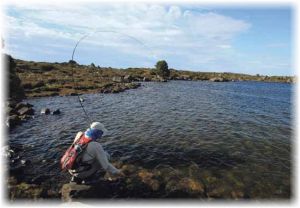 Presented from Issue 108, February 2014
Presented from Issue 108, February 2014
One of Tasmania’s most experienced Western Lakes anglers, Craig Rist, explains what’s in his day pack and why.
What to pack for a day out West is something I consider very carefully through out the season. The time of year and the expected weather conditions for a particular day will dictate what I throw into my pack. How many kilometres I expect to walk into the heart of the Western Lakes, away from civilization, is another factor I consider, especially if it’s going to be a solo trip and you don’t have anyone to help you limp out with a broken or sprained ankle.
There are many things that can go wrong when you step foot into this harsh, but beautiful environment. The terrain in this part of Tasmania isn’t easy to walk on and you can’t condition yourself by racking up the kilometres walking on the footpath before a trip. This terrain becomes your knees, feet and ankles, worst nightmare with the constant rolling and twisting that takes place with every step. It’s just something you have to go out and do, the more trips you have the easier it all becomes.
 |
| A well organised pack is essential |
Taking distance into account
A day walk can be an easy day out from base camp which has more fishing than walking or it can be that epic single dusk till dawn trip from a lonely car park at the foot of the Walls Of Jerusalem. Carrying too much or too little gear can be the difference between a good day and a very bad one.
There’s a big difference between spending a day on the water close to civilization and one that takes half the day to reach your destination. A pack that has everything in it but the kitchen sink will leave you sore, unbalanced and fatigued. A pack that has very little in the way of clothes and survival gear may be easier to carry, but you take the chance of placing yourself in a very unforeseen and uncomfortable situation, a long way from home.
Essential items
These are the things I always take with me on whenever I am going on all day hike, many kilometres into the Western Lakes.
- First aid kit with at least one pressure bandage.
- Survival blanket
- EPIRB (Emergency Position-Indicating Radio Beacon),
- Headlamp or torch
- Flint lighter
- Compass
- Maps
When it comes to putting together a first aid kit for these conditions I always like to have items that can cater for those more unfortunate situations such as snakebite, blisters, lacerations, sprains, and broken bones. I’ll also throw in a few over the counter painkillers for those unexpected headaches or more serious situations to take the edge off. To complement a first aid kit a survival blanket is very comforting to have in your pack when your core body temperatures start to drop and hypothermia is a real possibility.
 |
| Great scenery awaits you ! |
An EPIRB (Emergency Position-Indicating Radio Beacon) is something I have always carried when I go on a solo trip. I now use a satellite messaging device such as the Spot 2 Messenger which allows custom preset messages to be sent to your friends or family via text or email to let them know you are okay or that you need help from them and not the rescue helicopter. Which is a nice option when you are out of mobile coverage. One of the great functions when the message is sent to a email address is that it sends a link to Google maps with the precise location of the Spot2 messenger at the time the message was sent.
As well as the preset messages, which can be change online and used at anytime. The device also has a button dedicated to initiate the Emergency Response Authorities. The down side to this device is that the messages can only be sent and not received by the device. However the newer models, do allow for two-way text communication, which would obviously allows confirmation that someone has received your message. I am yet to make the upgrade to this new satellite messenger device but from what I have read and heard about them, an upgrade won’t be far away.
I always like to carry a head lamp or hand torch with me on a day walk. Because there is always a lake to explore over the next hill and before you know it getting back to the car in day light hours has long gone. It’s also very hard for me to leave rising fish in the evening and walking back in the dark over this terrain is a very dangerous option. Having a torch in the pack just takes the stress out of having to make it back out to the car or base camp before nightfall. A torch also allows you to start the walk before dawn and cover a few more kilometres before you reach water that holds fish.
A flint lighter has obvious survival advantages particularly if you’re unlucky enough to get stuck in the Western Lakes over night. It’s amazing how comforting a fire can be when you’re lost or freezing cold. Fortunately I have never had this happen to me but I know people who have and a fire can definitely save you life.
A map of the area and a compass are not only good survival tools they are a must when you want to find those new fishing spots. A GPS is a great tool to have as well as maps of the area but they are no use to you if the battery charge runs out. I like to save the battery life of mine for when the fog rolls in or for walking at night.
Keeping It Simple
When it comes to cutting down on weight I take only what I really need in the way of fishing gear. One fly rod and reel, one small box of flies, a spool of 4 and 6 pound tippet material, some line sink and my two favorite floatants, Gink and Frogs Fanny. I might go a little over board when it comes to camera gear, lugging in a big heavy SLR, lenses and a tripod at times. But that side of fishing has become very rewarding to me so I’m willing to carry the extra weight. I have since cut down on a landing net, which was used solely to support the fish in the water while I set the camera up for a shot. I now simply use the netting from a landing net, which has a drawstring attached to keep the fish calm and out of the silt, while I prepare the camera. By the time I have finished taking a few photos the fish is fully revived and ready to be released.
 |
| When it's cold, walk in your waders! |
 |
| Take care with sun protection |
Preparing for the cold.
When it’s wet and cold at the start of the season and then again at the end of the season, hypothermia is a real possibility if you haven’t packed some basic survival equipment. During this time I like to fill a dry bag with a selection of light to heavy weight thermal or merino blend tops, leggings, gloves, bandanas or neck warmers and a spare pair of merino blend hiking socks. A raincoat made from breathable material is always in my pack at these times, as well. If you’re warm and dry you can keep focused on the task at hand, catching a fish. But if you allow yourself to become wet and cold then your willpower to fish will be sucked away from you as quickly as your plummeting body temperature.
When I know it’s going to be really cold, I’ll throw in a small gas stove to make a hot drink or cook some noodles,our bodies need fuel to keep warm and eating or drinking something hot is a real treat. I’ve recently discovered the Jetboil gas cooker which is super fast at boiling water. Now my old single gas burners have been made redundant. I would highly recommend them for any hiking trip.
I find one of the best ways to stay warm and dry, particularly early and late in the season, is to start and finish the walk wearing breathable stocking foot waders with a pair of lightweight wading boot.
These waders are so good these days that you barely know you’re wearing them. They really come into their own when there are multiple creek crossings and tracks covered in water. I don’t think there a better way to stay warm, dry and focused on the game at hand during these cold and often wet conditions.
In the heat of summer
When the temperature rises during summer, everything comes to life in the Tasmanian bush. This is a great time to explore some remote trout fishing locations. Many types of insects are either hatching or being blown onto the water at this time, which brings trout out from under the rocks and deep weed beds to where we as anglers can see them. On a blue-sky day this place is truly sight fishing heaven and catching fish in this environment is quite unique to Tasmania.
Sun protection is a must at this time of year and 50+ Invisible Zinc sunblock is something I try very hard not to forget. Micro fibre head and neckware such as the Groper or Buff bandanas are becoming more popular and work extremely well against sun and windburn. Time seems to slip away so fast when you’re fishing and missing that re-application of sun block has often caught me out. So I will be like so many other anglers and have my face completely hidden under one of my favorite bandanas.
Craig Rist
